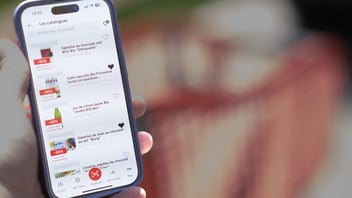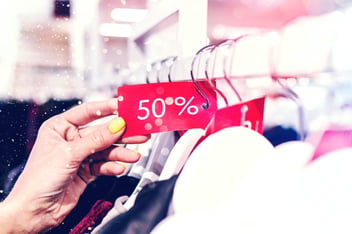🕗 3 min read ・ Not all retailers rely on e-commerce as much as we might imagine. For businesses such as home furnishings, DIY, and supermarkets, footfall remains king.
7 tips for driving footfall with personalised promotions

Not all retailers rely on e-commerce as much as we might imagine. For businesses such as home furnishings, DIY, and supermarkets, footfall remains king.
3 min read
Not all retailers rely on e-commerce as much as we might imagine. Some verticals don’t lend themselves to online sales either because the product is bulky and delicate or because the customer wants to physically interact with the product before purchasing. For businesses such as home furnishings, DIY, and supermarkets, footfall remains king.
The question, then, is how to drive footfall. Inspirational and aspirational content in brochures combined with promotional offers has been a key lever in strategies designed to increase the frequency of a shopper’s store visits. But as demographics and acceptable ecological norms shift, so do the ways in which stores engage with their customers. According to GE Capital Retail Bank's Second Annual Shopper Study, some 81% of retail shoppers conduct online research before going in-store. The obvious place to start is online, but the road to digital has been bumpy. Retailers whose web presence is not strong have fewer opportunities to display compelling promotions to their customers via their own web assets.
One large home furnishings company we spoke to was using PDF catalogues of offers on their website but had only tracked a handful of views of it in the last six months. The question they were asking was: “Should we stop producing a PDF offers catalogue if it’s receiving so few views?” Our answer was yes.. and no.
We thought it would be helpful to share with you some of best practices for implementing a digital promotions strategy that drives footfall.
1. Get organised
Bring your data assets together through API into a structured form that can be readily manipulated and repurposed for promotional activities.
The data required to plan, build and execute a promotions-based campaign designed to drive footfall is vast. A retailer will need to assemble loyalty, store, product, pricing, stock, POS, and services data. The challenge is that much of this data is hosted in different legacy and cloud systems in different locations. Some data may even be in static spreadsheets held by regional stores. The problem is compounded by a lack of communication: on average, a retailer’s promotion planning and execution will involve 4 siloed teams working independently from each other and using different standards.
Bringing it all together is time-consuming and resource-heavy in the first instance, but it’s worth the effort for the cost and time savings it will bring in the medium term. An API-first implementation will allow you to pull promotions into your marketing communications wherever they happen.
2. If you build it, they probably won’t come
Ok, so I’ve butchered the famous quote from Field of Dreams, but unless you’ve got a substantial number of regular website or app visitors, you have a lower probability that customers will notice an offers catalogue on your website.
Promotions will only convert into footfall and sales if the customer has seen and engaged with the offer. To maximise engagement, promotions should be repeatedly diffused on the channels that your shoppers already use. For instance, paid channels, such as Facebook, Instagram, and TikTok in combination with your own assets to drive traffic to your app. As more users sign up and engage with your content, you can re-balance your reliance on paid channels.
For maximum engagement, Integrate and align with aspirational content that draws in the consumer, such as recipes, interior decoration examples or DIY tips.
We know that providing a personalised experience by displaying content that matches the customer's interests provides better customer satisfaction because, a. shoppers tell us they expect it and, b. we know that conversion and basket size increase. The same benefits for the shopper apply with drive-to-store programs but, arguably, the personalisation is more nuanced still. This is because drive-to-store personalisation may need to take into account more than just purchase history and look-alike products. Local considerations, such as socio-economic factors, can also be embedded into the personalisation algorithms.
3. Make it personal
The vast majority of shoppers expect a personalised experience. And even if they didn’t, you’d want to create one!
Shoppers are inundated with ads and offers. So, the only way for you to rise to the top of all that noise is to speak directly to the person with offers that you know they will love. Use the first-party data you are capturing through your loyalty scheme to predict what the customer is looking for and propose similar and adjacent offers with a much higher chance of conversion. For instance, Franprix, a major chain of convenience supermarkets in France, saw their offer redemption rate jump by 5X when they started personalising the promotions.
4. Monetise to finance campaigns
Spend time with your brands to explain the value of personalisation to them in order to increase their advertising spend with you.
Personalisation isn’t just an opportunity to sell more stuff and increase footfall; it’s also an attractive proposition for your suppliers and your brands. A personalised promotion is essentially a premium product for which brands will pay a premium price. One retailer we work with added 12% to their advertising budget from brands with this approach, allowing it to finance its entire promotions operation just from monetisation revenue.
5. Align in-store and online strategies.
According to Epsilon, retailers that align their in-store and online promotional activities see a much greater ROI than those that run both independently, or that push one to the exclusion of the other.
A high proportion of shoppers do their research online before going into store, so it makes sense to make the online-to-offline experience as joined-up and symbiotic as possible. An example of this is offers in-store that are conditional on consulting the retailer’s app for a code.
This approach goes beyond the requirement to be a loyalty card member to benefit from a promotion and helps the retailer build a larger app user base that can be marketed to at a lower cost than through other channels
6. Organise nationally, activate locally
We already discussed getting data into a single system via API and building promotions centrally. But, to tap into the power of digital promotions, the offers need to make sense not just for the retail group but also for the customer of the local branch AND the store itself.
- Engage with agencies that know the local landscape and demographic to help manage local online and DOOH campaigns.
- Spend time with your local store teams or franchisees to ensure that your promotional and revenue goals are aligned. Look at sharing revenues from monetisation for instance.
- Ensure that your choice of promoted products resonates with the local population and meets customer expectations by ensuring stock availability for promoted items.
7. Measure the omnichannel mix and re-mix
A major advantage of a joined-up offline and online approach is the ability to monitor cause and effect and adjust in real time. Contrary to what a PDF offers catalogue can provide, a fully integrated and personalised online experience through a custom front end will allow you to adjust the mix between paid and proprietary channels and to understand which promotions convert the nest under which circumstances.




Leave a Comment